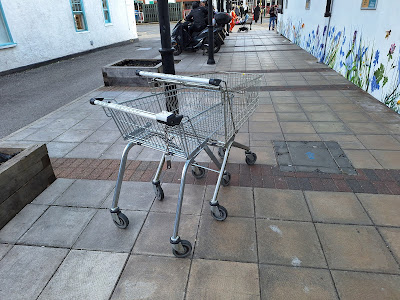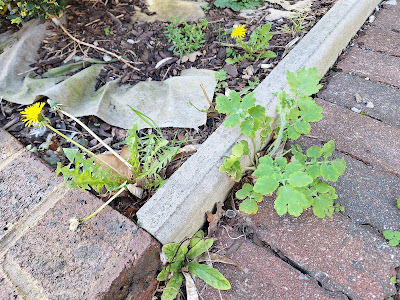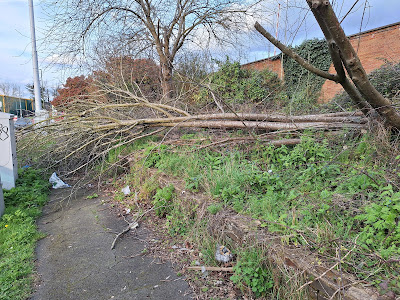A couple of weeks ago to the Wigmore Hall to hear Elisabeth Brauss give us some Prokofiev (from Op.12), Albéniz (from Iberia, Book 1) and Beethoven (Op.31, No.3, 'Hunt'). Brauss - or perhaps Brauß - is to be found at reference 1. A Radio 3 concert, one of the Monday lunchtime series.
A dull morning which started with some serious damage to someone's fox-proof food waste caddy. The lengths a fox will go to to get to someone's potato peelings and cast-off McDonald's.
Then part of our carriage on the tube to Oxford Circus was occupied by what looked like a young man crashed out, face down, spread over three or four seats, the sort facing across the carriage, by the doors. Not clear what had happened to the arm rests, but he did appear to be breathing, so we all just left him be.
Got to All-Bar-One to find that the tables had been slightly rearranged and a new manager. We had a very cheerful waiter - and a double ration of smarties. After which we took our cheese scones, left over from the day before, previously noticed at reference 2, in Cavendish Square. Enough to tide us over until lunch after the concert to come.
A concert which down very well; we must both have been on form - and I had done a bit of revision on the Beethoven, which seems to be a good idea these days. For an encore I think we had the slow movement from Op.14, No.2.
Out to try for the Mozza pizzeria attached to the Treehouse Hotel in Langham Place, a pizzeria which I rather like. But shut once again - but not closed down. This morning I find that it is open Tuesday to Saturday - which explains why it is never open when we are around. A pity, as I can't see us making a special trip there. See reference 3.
Back across the road to the Wigmore, to find that it was open and ready to serve us. So we finally get to eat there, with my having visiting the place for a glass several times over the years, for example, as noticed way back in 2017 at reference 5. An establishment which still belongs to the Langham Hotel next door if the email address given on the 'Find Us' page is anything to go by. An establishment which, curiously, shuts at noon on Sundays, which explains why we never get in on a Sunday.
I took 'buttered crumpets, steamed cock crab (229 kcal)' to start, while BH just nibbled. What some places call an 'amuse bouche', but I rather liked it.
I am sure I read in one of our cookbooks recently that hen crabs are best, but reference 6 is not having it, with their story being that 'male brown cock crabs are larger than female (hen) crabs, have large claws, a high white meat content with brown meat that is a little less sweet than the hen crab. The large claws make for easy picking out of the white meat'. This next to an entry for 'W Harvey & Sons', which looked to be selling crabs too, but which Bing correctly flagged as a cover for pornography. Poor old crabs.
We both took the 'slow-cooked beef and onion pie, mash (1157 kcal)', which was decently presented, but adequate rather than good. A bit too rich and a bit too small, leaving one feeling that one had not eaten properly. To be fair, BH was in better case than I as far as that went. No greens to go with it. No Calvados, despite the grandeur of the establishment - including the elaborate wooden floor already noticed at reference 5.
No orange jelly or tinned peaches for dessert - although we could have had three cheeses from Neal's Yard Dairy. Never quite understood why people like to take several cheeses at once: I prefer to stick to the one. Same with bitter beer when I used to drink that.
But we did get a very cheerful young waitress who told us all about the need for foot care in her line of work, this à propos of her smart looking shoes, which went very well with the rest of her outfit. Which included something you sprayed on (the feet) to keep them under control.

Took the back streets to get us to Tottenham Court Road, taking in this line of scooters on the way. Media Lab are to be found at the visually noisy reference 7 and describe themselves as the largest independent media agency in the UK, the catch there being that I don't have a clue what one of those might do, despite their holding an IPA effectiveness accreditation, whatever that might be. In my day IPA was a sort of bitter beer. Why in this day and age of full fibre connections to everywhere and everything do they need lots of people rushing about on scooters? Something to do with needing hard copy of something to be sure of the colours and so forth? Something we know all about in connection with choosing the new lino for our kitchen refit. Fake stone naturally.
We paid a good visit to the flashy gothic revival church - All Saints - in Margaret Street. My carafe of white - possibly 'Picpoul de Pinet, Sel et Sable, Languedoc, France 2022' - plus a spot of Jameson had got me into just the right frame of mind to appreciate the elaborate interior decoration. Not the sort of thing one associates with the stuffy old Church of England at all. No organ accompaniment on this occasion. And there was a young male tourist who was not showing much respect to others. I might, for all he knew, have been praying.
Someone with a spot of bother. Looks like the same sort of fibreglass that large parts of our more modest vehicle are made of.
Some subdued decoration to a building in Berners Street. See, for example, the motif above the big windows. The transition from the elaborate stone trim of the Edwardian era to the flush finishes of blocks of the 1960s?
BH was quite clear that she did not want to visit this establishment, even more visually noisy, at the top of Charing Cross Road. Not quite sure what it was about either.
But the late afternoon light made for some interesting townscapes. For example, the theatre at Cambridge Circus.
Cheese from Neal's Yard Dairy in Shorts Garden. The usual ration of around a kilo of Lincolnshire Poacher, taken in two pieces, wrapped separately. They have a clever way of wrapping the cheese in greaseproof paper (or something) which seems to make it keep pretty well in the refrigerator.
Tube to Waterloo. On which we were entertained by a young lady with extravagant extensions to her fingernails. Elaborately painted, with flecks of purple against a paler background, and with no attempt being made to hide the fact that they were extensions. Got up, in fact, rather as if they were a sort of jewellery.
And so home.
PS 1: this morning, I have failed to find the advice about hen crabs. Not the Boston Cook Book and not the newly acquired Settlement Cook Book, this last acquired after an interchange with Google's Gemini about Pepys and kedgeree, as previously reported. But I have learned that crabs moult their shells, an expensive business which leaves them very vulnerable for the duration. See, for example, reference 8. It doesn't say what happens about the legs and claws, which one might think needed shedding to accommodate growth too.
PS 2: and then to read about yet another expensive pickle that the Serious Fraud Office has got itself into, on this occasion with Russian oligarchs and their mining company. Now moved to Luxembourg where they are even more forgiving than we are. City wide boys seem to be able to run rings around the Fraud Office, it seeming to be just one failure after another.
References
Reference 1: https://www.elisabethbrauss.com/.
Reference 2: https://psmv5.blogspot.com/2024/03/cheesy-nostalgia.html.
Reference 3: https://www.treehousehotels.com/london/offers/ciao-mozza. The pizza.
Reference 4: https://the-wigmore.co.uk/. The pub.
Reference 5: https://psmv3.blogspot.com/2017/09/wigmore-two.html.
Reference 6: https://www.freshfishonline.co.uk/shop/shellfish/live-cock-crab/.
Reference 7: https://medialabgroup.co.uk/.
Reference 8: https://www.bangor.ac.uk/natural-sciences/news/how-does-the-crab-shed-its-shell-22903.
Reference 9: https://crabstreetjournal.org/blog/2012/10/14/what-is-molting/. A rather more elaborate take on moulting in hermit crabs. Lots of stuff out there, so there are clearly plenty of people who are interested in this.























































